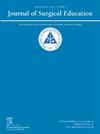Diversifying the Surgical Workforce: Understanding Barriers to Inform Solutions
IF 2.6
3区 医学
Q1 EDUCATION, SCIENTIFIC DISCIPLINES
引用次数: 0
Abstract
OBJECTIVES
Race and gender concordance between physicians and patients is associated with reductions in healthcare disparities. However, the diversity of the medical workforce does not mirror the population; some of the greatest deficiencies exist in the surgical workforce. We conducted a pilot study focused on early recruitment of diverse college students in our region, with a concurrent needs assessment of their specific barriers to entering the field of surgery.
METHODS
Local college students who self-identified as underrepresented in medicine (URiM) were recruited to attend a symposium hosted by an academic surgery department. Events included a specialty discussion panel, live OR streaming, simulation lab, and breakout sessions covering various topics. The primary aims were to 1: increase interest in surgical careers and 2: conduct a needs assessment to optimize strategies for overcoming perceived barriers to entering surgery. A mixed methods analysis was conducted to assess cohort characteristics, changes in impressions of pursuing a surgical career, barriers to pursuing such careers across five domains, and overall perceptions of the symposium.
RESULTS
Recruitment consisted of emails sent to local college pre-medical society advisors. Of 58 students who attended, 77% were from state universities or community colleges. There were 63.8% who identified as a racial/ethnic minority (38% Latino, 24% Black, 16% Asian, 14% Middle Eastern, 8% mixed), 34.5% as economically-disadvantaged, 34.5% as first-generation college, 25.9% as female, 12.1% as LGBTQ+, and 3.5% as other. Pre-symposium, 93% of attendees intended to apply to medical school, but only 25% had considered surgery as a profession. Post-symposium, this increased to 43% who indicated an intention to pursue surgery, with an additional 52% who were undecided but interested. Across all sections, the mean rating for attendees’ knowledge regarding surgical training and careers pre- and post-symposium increased significantly. The most frequently cited barriers were the lack of mentors (50%), concerns about MCAT scores (50%), overall costs (48%), and work/life balance (47%). Thematic analysis identified gratitude for the event and for opportunities to meet surgeons; ongoing needs included shadowing and mentorship matching. The direct costs of the event were approximately $500.
CONCLUSION
This pilot study demonstrated the avidity of an audience with the potential to diversify the surgical workforce. Participant interest in pursuing surgical careers nearly doubled and clear unmet needs were identified to support this group towards this goal. Furthermore, these results were achieved with very little funding or advertising. Work is ongoing to upscale these efforts and determine impact on our surgical workforce.
多样化的外科劳动力:了解信息解决方案的障碍。
目的:医生和患者之间的种族和性别一致性与医疗保健差异的减少有关。然而,医疗人员的多样性并不能反映人口;一些最大的缺陷存在于外科劳动力中。我们进行了一项试点研究,重点是在我们地区早期招募不同的大学生,同时对他们进入外科领域的具体障碍进行需求评估。方法:招募自认为医学代表性不足的本地大学生参加由某学术外科主办的研讨会。活动包括专业讨论小组、直播或流媒体、模拟实验室和涵盖各种主题的分组会议。主要目标是:1:增加对外科职业的兴趣;2:进行需求评估,以优化策略,克服进入外科的感知障碍。采用混合方法分析来评估队列特征、追求外科职业印象的变化、跨越五个领域追求外科职业的障碍以及对研讨会的总体看法。结果:招募包括通过电子邮件发送给当地大学医学预科协会顾问。在58名入学学生中,77%来自州立大学或社区学院。63.8%的人认为自己是少数种族/族裔(拉丁裔38%,黑人24%,亚裔16%,中东14%,混血儿8%),34.5%的人是经济弱势群体,34.5%的人是第一代大学生,25.9%的人是女性,12.1%的人是LGBTQ+, 3.5%的人是其他。研讨会前,93%的与会者打算申请医学院,但只有25%的人考虑将外科作为一种职业。研讨会后,这一比例增加到43%的人表示有意进行手术,另有52%的人尚未决定但有兴趣。在所有部分,与会者对外科培训和职业知识的平均评分在研讨会前后显著增加。最常见的障碍是缺乏导师(50%)、担心MCAT分数(50%)、总体成本(48%)和工作/生活平衡(47%)。专题分析确定了对该活动和有机会见到外科医生的感激之情;持续的需求包括跟随和导师匹配。这次活动的直接费用约为500美元。结论:这项初步研究证明了观众的热情,有可能使外科工作人员多样化。参与者追求外科事业的兴趣几乎翻了一番,明确了未满足的需求,以支持这一群体实现这一目标。此外,这些成果是在很少的资金或广告的情况下取得的。工作正在进行中,以提高这些努力,并确定对我们的外科工作人员的影响。
本文章由计算机程序翻译,如有差异,请以英文原文为准。
求助全文
约1分钟内获得全文
求助全文
来源期刊

Journal of Surgical Education
EDUCATION, SCIENTIFIC DISCIPLINES-SURGERY
CiteScore
5.60
自引率
10.30%
发文量
261
审稿时长
48 days
期刊介绍:
The Journal of Surgical Education (JSE) is dedicated to advancing the field of surgical education through original research. The journal publishes research articles in all surgical disciplines on topics relative to the education of surgical students, residents, and fellows, as well as practicing surgeons. Our readers look to JSE for timely, innovative research findings from the international surgical education community. As the official journal of the Association of Program Directors in Surgery (APDS), JSE publishes the proceedings of the annual APDS meeting held during Surgery Education Week.
 求助内容:
求助内容: 应助结果提醒方式:
应助结果提醒方式:


